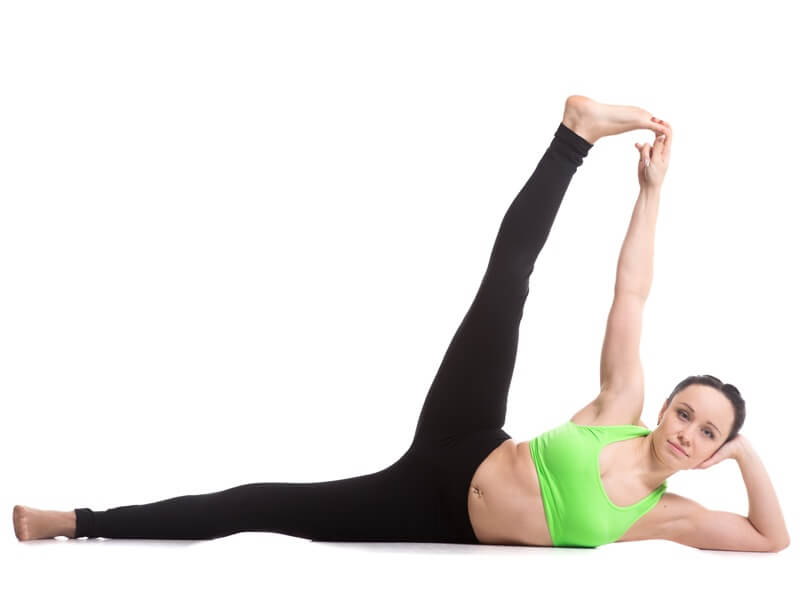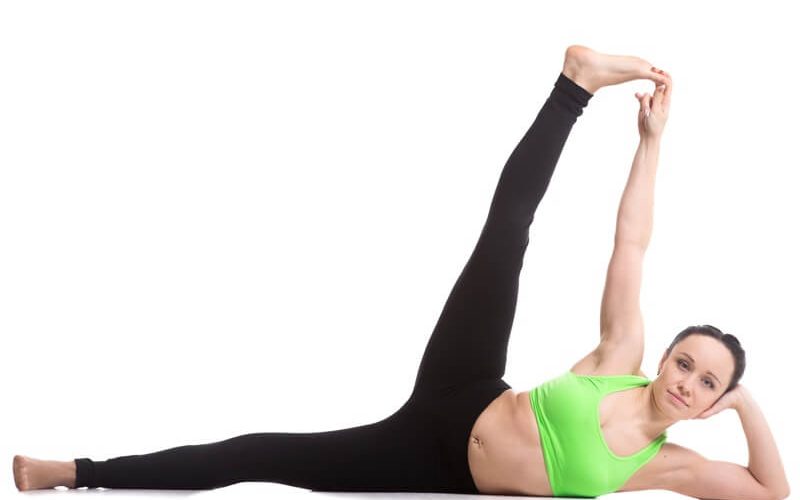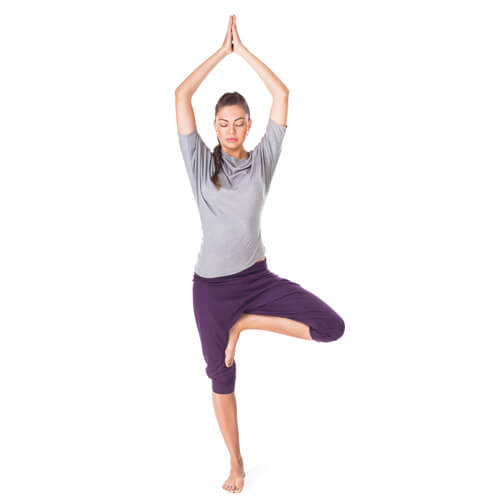Did you know Anantasana is one of the most relaxing and balancing postures to practice? It’s also known as ‘the pose of Lord Vishnu’s infinite serpent’. Anantasana is named after Ananta, the preserver of the universe, and by practicing it you can find a connection to your own inner potential. Through regular practice, you can also achieve a deep sense of relaxation, balance, and flexibility, all while honoring the divine qualities of Lord Vishnu and Ananta.
Anantasana, also known as Vishnu’s Couch Pose, can also be called different things in other types of yoga. These include Side-Reclining Leg Lift, Eternal One-Legged Pose, Sleeping Vishnu Pose, Reclining Vishnu Pose, and Side Lying Leg.

Image Source: Shutterstock
This article will tell you about the advantages of Anantasana, the different ways to do it, and how to do it. Keep reading!
To Do Anantasa or Sleeping Vishnu Pose, Follow These Steps
This guide will help you practice Anantasana correctly so you can get the most out of this yoga pose. It’s simple and easy to follow.
- Put a yoga mat on the ground and lay on your left side.
- Now, put your right foot on top of your left foot in a symmetrical way.
- Stand on one foot and push down on your left heel while keeping your ankle steady.
- Straighten out your left arm so it is in line with your body, from your toes to the tips of your fingers.
- Put your left arm outside of your body and put it on the floor while you stretch your shoulder.
- Put your left hand under your head and sit up straight.
- Keep your left arm straight up.
- Turn your right leg up while spinning it.
- Pull your legs up towards your body as you bend your knees.
- Use your thumb and first two fingers to grip the right foot’s big toes.
- Move your tailbone against your hips to help you balance your lifted leg. Use the tailbone as a base when you lift your leg and take a breath in.
- Stay in this posture for around 30 seconds to one minute by pushing your heels down. This is the last yoga Anantasana position.
- Start by doing this pose for a little while, and then gradually lengthen the time as you become more comfortable.
- Stand on your left foot and loosen the grip of your legs and arms.
- Put your elbow on the left side of your body and put your right hand on your leg.
- Take a break for a moment and do Anantasana yoga for as long as it feels good.
Basic Poses for Anantasana
To make Anantasana easier, these are the poses you should do first:
- Supta Padangusthasana (Reclining Big Toe Pose).
- Utthita Trikonasana (Extended Triangle Pose).
- Parighasana (Gate Pose).
Benefits of Anantasana
- Anantasana practice can help make your torso, the back of your leg, and your hamstrings stronger and more flexible.
- Your back and leg flexibility will be greatly improved.
- Anastasia helps your digestion to be better by strengthening the muscles in your stomach.
- This pose can help you lose weight in your thighs and hips, as well as strengthen your pelvic area.
- Doing Anantasana regularly helps to make the blood flow in your legs much better.
- Exercising can help reduce stress and tension in your body, as well as provide relief from arthritis, colitis, hypertension, and sciatica.
- The Vishnu pose, a sleeping position, could help to fix issues with the urinary system, bladder, uterus, prostate, and ovaries.
Precautions To Be Taken
The Anantasana pose is easy and straightforward to do. But it’s important to take some precautions to prevent muscle strain or injury.
- Talk to a doctor before beginning to do the Anantasana pose every day, especially if you have spondylitis, cervical issues, or a slipped disc.
- If you have a spine condition like scoliosis, it’s best to not do the Sleeping Vishnu pose since it could make the condition worse.
- Hold off doing Anantasana if you have Sciatic pain or an injury to your shoulder.
Variations of Anantasana
If you are tired of doing the Asana, try changing it up with some variations or modifications of Anantasana.
- You can help your back by using something like a pillow or wedge while you lie back.
- Instead of stretching your toes, you can use a strap and wrap it around your ankles. This will make the side reclining leg lift pose in yoga much easier.
- If you want to make it simpler to do this pose, you can try a variation where you don’t need to lift your upper body and put your head in your left arm.
FAQ:
1. What things we should keep in mind while performing Anantasana?
Here are some important things to remember when doing Anantasana as a beginner, so you can get the most out of it:
- For beginners, putting your head in your hands can be too hard on your neck. To reduce the strain, try to use your torso to rest your head.
- At first, it can be difficult for new people to do this exercise correctly.
2. What is the science behind Anantasana?
Doing Anantasana may feel like you’re just relaxing, but it actually requires balance, flexibility, and strength to do it comfortably. It can also help you find inner peace and encourage you to look inward.
3. Is it possible for anyone to do Anantasana?
When doing Anantasana, it is important to be aware of your body’s capabilities and limitations. If you are a beginner, it may be helpful to use blankets or bolsters for extra support. However, if you have any injuries or medical conditions, it is best to get advice from a professional before attempting the pose.
Read More:



